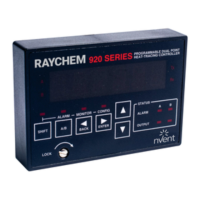33 / 82
EN- Raychem920series-IM-H5687405/15
INDUSTRIAL HEAT TRACING SOLUTIONS
Procedure: Enable or disable the alarming of a failure of the designated control temperature
sensor as required.
IMPORTANT: This alarm should always be enabled. If the controller experiences a CONTROL
TS FAILURE it will turn the output off or on (as spec-ified by TS FAIL MODE) until this alarm is
cleared. If the TS CONTROL MODE uses the EXTERNAL INPUT, a CONTROL TS FAILURE is self-
clearing (i.e., is nonlatching).
3.8 OTHER ALARMS
This Section defines the nontemperature-related alarming functions of the 920 controller: current,
ground fault, voltage and resistance. These parameters must be set up individually for both Point
A and Point B.
3.8.1 LOW LOAD CURRENT ALARM
Purpose: Alarms current levels that are lower than a preset limit for the application. Monitoring
for lower-than-expected current levels may be an effective means of continuity monitoring. See
also HIGH RESISTANCE ALARM in section 3.8.14 on page 39.
Alarm Mask: ENABLE or DISABLE
Range: 0.3 to 100.0 amps
(CURRENT TURNS RATIO = 1.00)
Procedure: Adjust the LOW CURRENT ALARM level to the desired value. Note that the LOW
CURRENT ALARM must be enabled in order to adjust the LOW CURRENT ALARM level. Also note
that the LOW CURRENT ALARM level is affected by the CURRENT TURNS RATIO setting. The
absolute maximum adjusted LOW CURRENT ALARM level is 300.0 amps. The absolute minimum
adjusted LOW CURRENT ALARM level is 0.1 amps. See section 3.5.22 on page 26 for more
information regarding the CURRENT TURNS RATIO function.
Notes (V3.00 only):
• TominimizenuisanceLOWCURRENTALARMS,theHTCmustdetectacurrentlevellessthan
the LOW CURRENT ALARM setpoint for a period longer than approximately 20 consecutive
seconds.
• Forseries-typeheatingcables,adjustingtheLOWCURRENTALARMto50%offullloadcurrent
will properly alarm a problem and reduce nuisance alarms due to voltage dips. Parallel heaters
should be adjusted to a level as close as possible to full load current but lower than the current
at worst-case voltage. The low current setting as a percentage of full load current will vary
depending on the facility and its power system.
• ALOWCURRENTALARMmayalsoresultfromaswitchfailedopen.Thecontrollercannot
detect a switch failure due to no current. A no current condition would be identified by a LOW
CURRENT ALARM (if enabled) and the analog value reported with the alarm will be 0.0 A.
• ItmaybeadvantageoustoconsiderusingtheHIGHRESISTANCEALARMtoindicateacable
fault when using certain types of heaters. See sections 3.8.12 on page 38 and 3.8.14 on page 39
for an explanation of the resistance alarming feature.
3.8.2 LOW LOAD CURRENT ALARM FILTER TIME SETTING (V3.11 AND UP)
Purpose: The LOW CURRENT ALARM FILTER will prevent LOW LOAD CURRENT ALARMS from
being indicated until a low current condition has existed for the duration of the LOW CURRENT
ALARM FILTER time.
Range: 0 to 12 seconds
Procedure: Adjust the LOW CURRENT ALARM FILTER time to the desired value. Note that the LOW
CURRENT ALARM must be enabled in order to adjust the LOW CURRENT ALARM FILTER time.
IMPORTANT:
• Ifanalarmconditionappearsandthendisappearsbeforethealarmfiltertimehasexpired,the
filter timer is reset and the alarm condition must exist again for the entire alarm filter time
before the corresponding alarm will be indicated.

